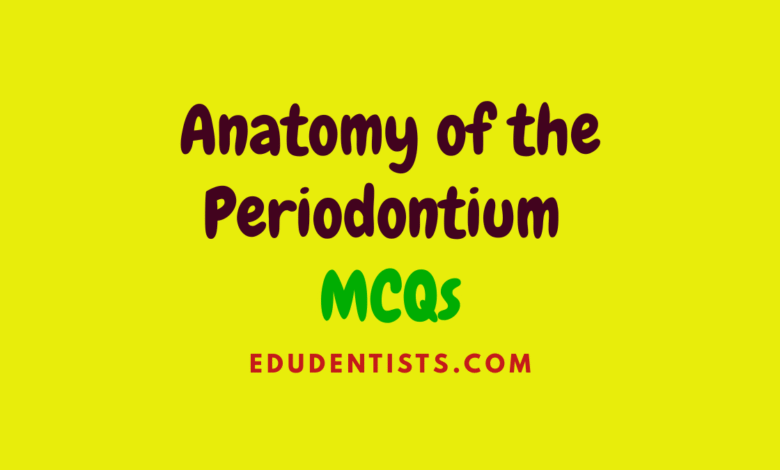
Anatomy of the Periodontium MCQs
👉Anatomy of the Periodontium Lecture
Anatomy of the Periodontium MCQs
1. The oral mucosa consists of how many main zones?
a. 2
b. 3
c. 4
d. 5
2. Which of the following is part of the masticatory mucosa?
a. Lining mucosa
b. Gingiva and hard palate
c. Dorsum of the tongue
d. Floor of the mouth
3. Specialized mucosa covers which area?
a. Hard palate
b. Alveolar processes
c. Dorsum of the tongue
d. Gingival sulcus
4. Lining mucosa covers:
a. Gingiva and hard palate
b. Dorsum of the tongue
c. Rest of the oral cavity
d. Alveolar bone
5. Gingiva covers which parts of the oral cavity?
a. Floor of the mouth
b. Dorsum of the tongue
c. Alveolar processes and necks of teeth
d. Soft palate
6. Normal adult gingiva covers slightly above the:
a. Free gingival groove
b. Alveolar bone crest
c. Cementoenamel junction (CEJ)
d. Periodontal ligament
7. Marginal gingiva is also known as:
a. Free gingiva
b. Attached gingiva
c. Interdental gingiva
d. Masticatory gingiva
8. Marginal gingiva forms which structure?
a. Interdental papilla
b. Soft tissue wall of the gingival sulcus
c. Alveolar mucosa
d. Junctional epithelium
9. The free gingival groove is usually how wide?
a. 0.5 mm
b. 1 mm
c. 2 mm
d. 3 mm
10. Gingival sulcus is shaped like:
a. U-shaped
b. Flat
c. V-shaped
d. O-shaped
11. Ideal depth of the gingival sulcus under experimental conditions is:
a. 0 mm
b. 1 mm
c. 2 mm
d. 3 mm
12. Normal histologic depth of human gingival sulcus ranges from:
a. 0–0.5 mm
b. 0.69–1.8 mm
c. 2–3 mm
d. 3–4 mm
13. Clinically measured probing depth of normal human gingiva is:
a. 0–1 mm
b. 2–3 mm
c. 4–5 mm
d. 5–6 mm
14. Attached gingiva is:
a. Firm and resilient
b. Movable
c. Unattached
d. Thin and delicate
15. Attached gingiva is demarcated by:
a. Free gingival groove
b. Mucogingival junction
c. Cementoenamel junction
d. Alveolar mucosa
16. Width of attached gingiva in maxillary incisors is:
a. 1.5–2 mm
b. 3.5–4.5 mm
c. 2.5–3 mm
d. 4.5–5.5 mm
17. Width of attached gingiva in mandibular first premolars is:
a. 3.3–3.9 mm
b. 2.0–2.5 mm
c. 1.8 mm
d. 4 mm
18. Interdental gingiva fills the:
a. Free gingival groove
b. Interproximal space beneath tooth contacts
c. Gingival sulcus
d. Mucogingival junction
19. Pyramidal shape of interdental gingiva is located:
a. In diastema
b. Tip under contact point
c. In mucogingival junction
d. In alveolar mucosa
20. Col-shaped interdental gingiva forms:
a. Free gingival groove
b. Valley connecting facial and lingual papillae
c. Alveolar mucosa
d. Periodontal ligament
👉Anatomy of the Periodontium Lecture
21. Gingiva acts primarily as:
a. Sensory organ
b. Protective barrier against mechanical and microbial damage
c. Secretory tissue
d. Bone support
22. Gingival epithelium consists of:
a. Single-layer cuboidal epithelium
b. Stratified squamous epithelium
c. Pseudostratified columnar epithelium
d. Transitional epithelium
23. Connective tissue core of gingiva is mainly composed of:
a. Elastin fibers
b. Collagen fibers and ground substance
c. Smooth muscle
d. Adipose tissue
24. Main function of gingival epithelium is to:
a. Produce enamel
b. Protect deep structures and maintain barrier integrity
c. Attach gingiva to bone
d. Support teeth mechanically
25. Principal cells of gingival epithelium are:
a. Melanocytes
b. Keratinocytes
c. Langerhans cells
d. Merkel cells
26. Non-keratinocyte cells include:
a. Only keratinocytes
b. Langerhans cells, Merkel cells, melanocytes
c. Fibroblasts
d. Osteocytes
27. Keratinization involves:
a. Loss of tonofilaments
b. Disappearance of mitochondria
c. Flattening of cells, keratohyalin granules, and loss of nuclei
d. Formation of fibroblasts
28. Orthokeratinized epithelium has:
a. Retained nuclei
b. No nuclei in surface layer
c. Partial nuclei
d. No keratin at all
29. Parakeratinized epithelium has:
a. Nuclei retained in surface cells
b. No nuclei
c. Only basal nuclei
d. No keratohyalin granules
30. Non-keratinized epithelium lacks:
a. Basal layer
b. Keratinocytes
c. Granular and corneal layers; surface cells have nuclei
d. Suprabasal layer
31. Basal cells produce which keratin first?
a. K1
b. K10
c. K19
d. K5
32. Higher-molecular-weight keratins like K1 appear in:
a. Basal cells
b. Suprabasal layer only
c. Cells migrating to the surface
d. Connective tissue
33. Keratinocytes are connected by:
a. Hemidesmosomes only
b. Desmosomes
c. Gap junctions only
d. Tight junctions only
34. Tight junctions (zonae occludens) allow:
a. Passage of large proteins
b. No passage at all
c. Passage of ions and small molecules
d. Passage of cells
35. Odland bodies in keratinocytes are involved in:
a. Mitochondrial respiration
b. Keratinization and intercellular cementation
c. Lipid storage
d. DNA synthesis
36. Melanocytes are located in:
a. Surface layer
b. Basal and spinous layers
c. Sulcular epithelium only
d. Junctional epithelium only
37. Langerhans cells function as:
a. Melanin producers
b. Tactile sensors
c. Antigen-presenting cells
d. Fibroblasts
38. Merkel cells are responsible for:
a. Immunity
b. Melanin production
c. Tactile sensation
d. Keratinization
39. Basal lamina consists of:
a. Type I collagen only
b. Lamina lucida and lamina densa
c. Elastin only
d. Fibronectin only
40. Anchoring fibrils function to:
a. Produce keratin
b. Produce melanin
c. Connect basal lamina to connective tissue and loop around collagen fibers
d. Form odontoblasts
